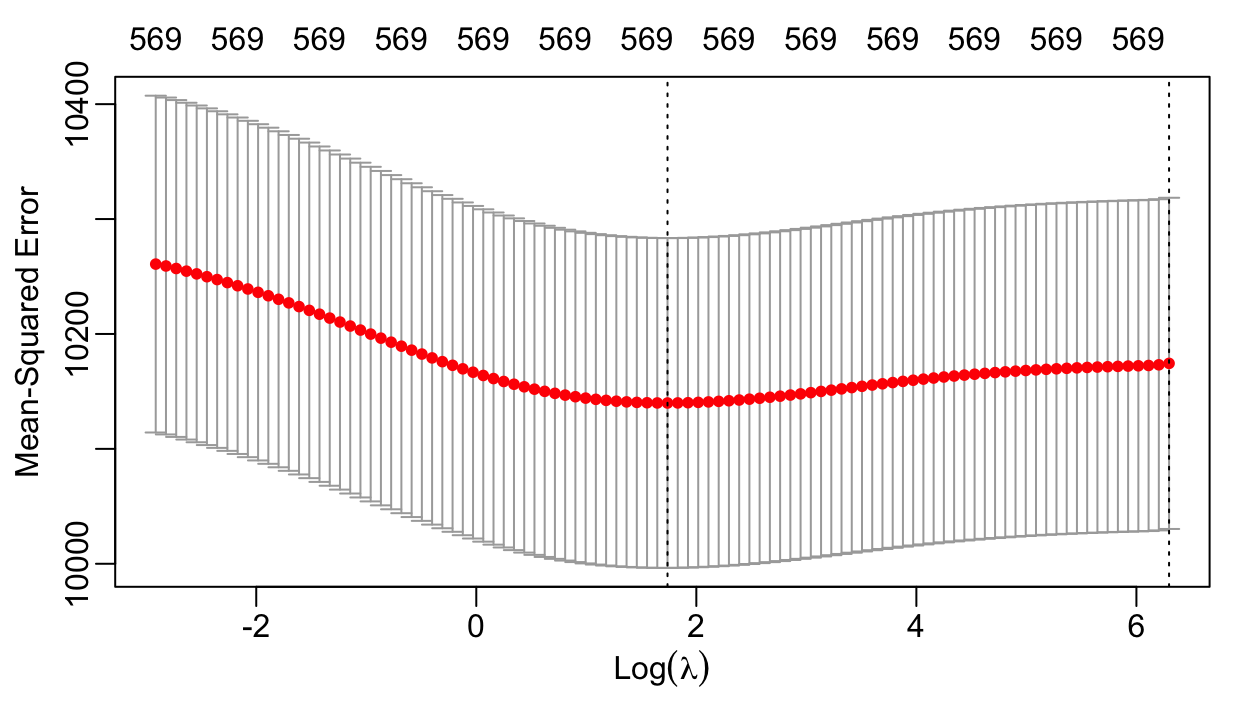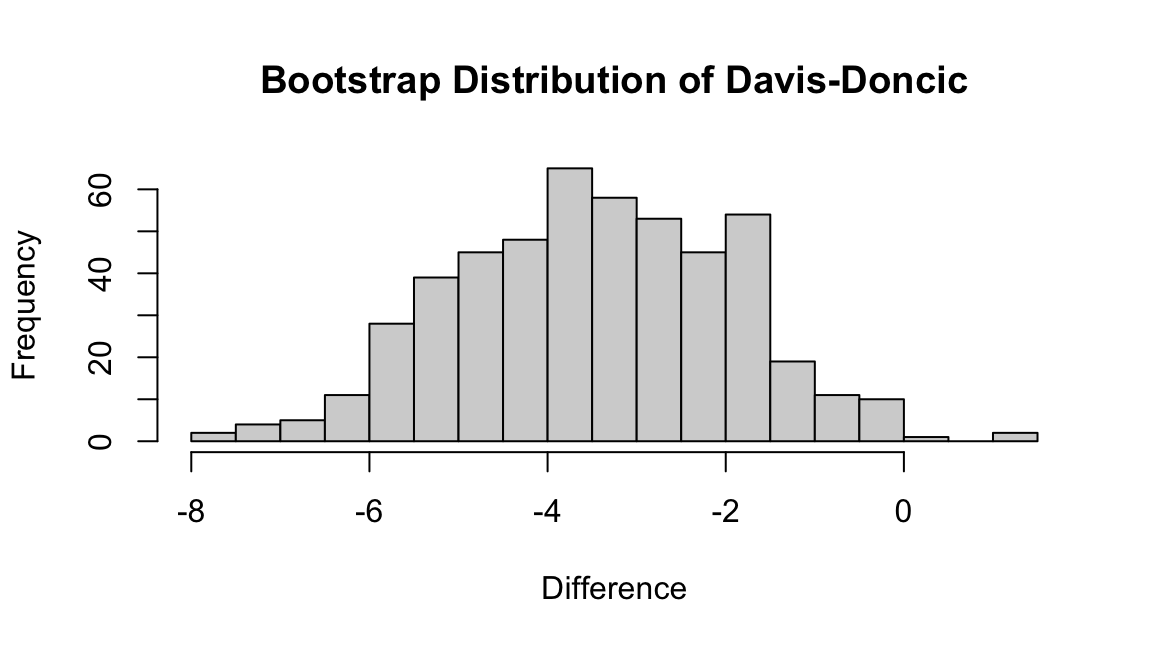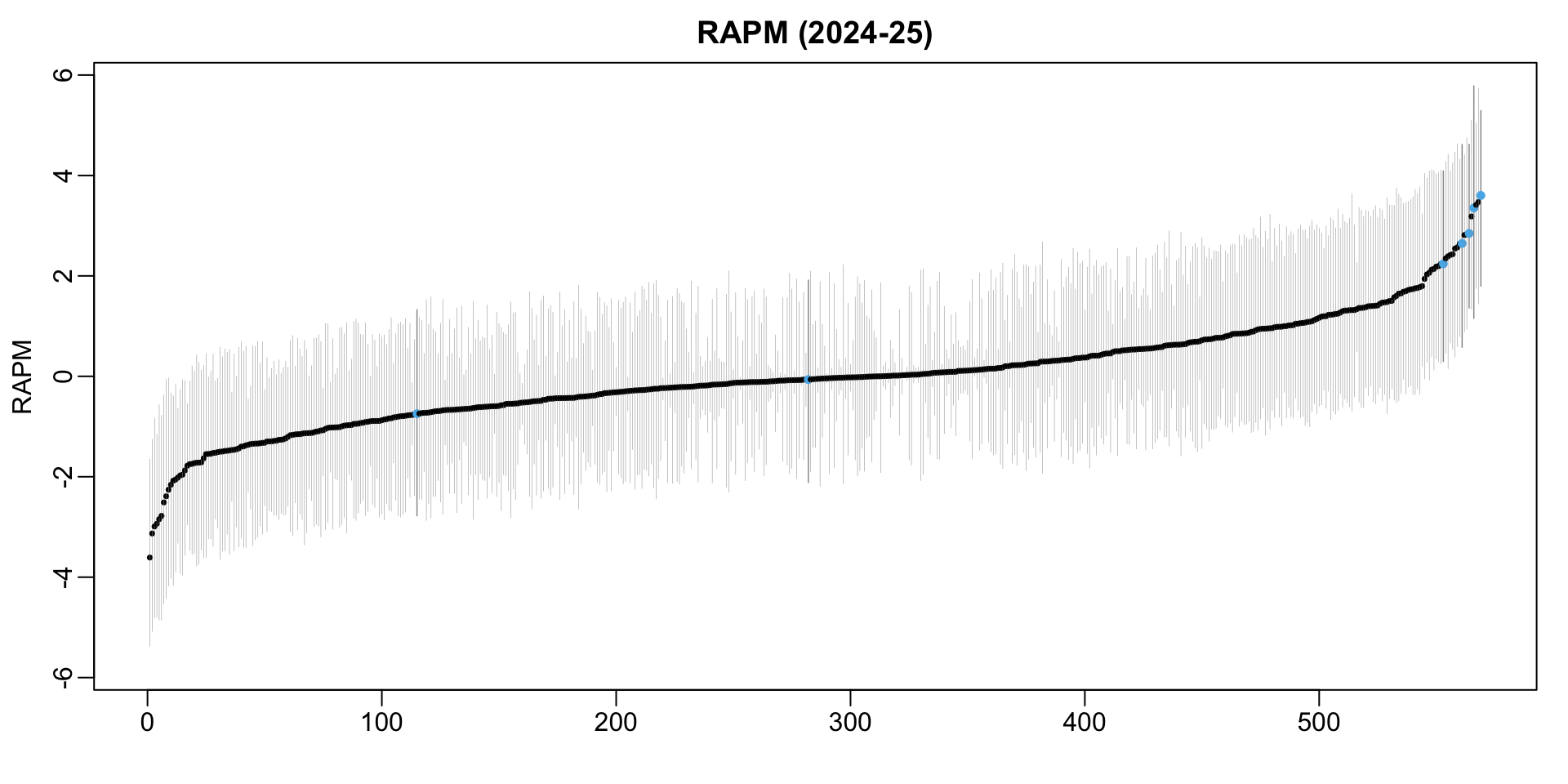STAT 479: Lecture 5
Regularized Adjusted Plus/Minus
Recap: Adjusted Plus/Minus
Motivation
- How do NBA players help their teams win?
- How do we quantify contributions?
- Plus/Minus: Easy to compute
- Hard to separate skill from opportunities
- Doesn’t adjust for teammate quality
- Adjusted Plus/Minus:
- Regress point differential per 100 possession on signed on-court indicators
- Introduces fairly arbitrary baseline
- Assumes all baseline players have same underlying skill
The Original Model
- \(n\): total number of stints
- \(p\): total number of players
- \(Y_{i}\): point differential per 100 possessions in stint \(i\)
\[ \begin{align} Y_{i} &= \alpha_{0} + \alpha_{h_{1}(i)} + \alpha_{h_{2}(i)} + \alpha_{h_{3}(i)} + \alpha_{h_{4}(i)} + \alpha_{h_{5}(i)} \\ ~&~~~~~~~~~~- \alpha_{a_{1}(i)} - \alpha_{a_{2}(i)} - \alpha_{a_{3}(i)} - \alpha_{a_{4}(i)} - \alpha_{a_{5}(i)} + \epsilon_{i}, \end{align} \]
Matrix Notation
- For each stint \(i\) and player \(j\), signed indicator \(x_{ij}\):
- \(x_{ij} = 1\) if player \(j\) on-court at home in stint \(i\)
- \(x_{ij} = -1\) if player \(j\) on-court and away in stint \(i\)
- \(x_{ij} = 0\) if player \(j\) off-court in stint \(i\)
- \(\boldsymbol{\mathbf{X}}\): \(n \times p\) matrix of signed indicators
- Rows correspond to stints:
- Columns correspond to players
- \(\boldsymbol{\mathbf{Z}}\): \(n \times (p+1)\) matrix
- First column is all ones; remaining are \(\boldsymbol{\mathbf{X}}\)
- \(i\)-th row is \(\boldsymbol{\mathbf{x}}_{i}\)
- \(Y_{i} = \boldsymbol{\mathbf{z}}_{i}^{\top}\boldsymbol{\alpha} + \epsilon_{i}\)
Problems w/ Original Model
- Individual \(\alpha_{j}\)’s are not statistically identifiable
- E.g. \(\alpha_{j} \rightarrow \alpha_{j}+5\) yields same fit to data
- \(\boldsymbol{\mathbf{Z}}\) is not of full-rank
- Can’t invert \(\boldsymbol{\mathbf{Z}}^{\top}\boldsymbol{\mathbf{Z}}\)
- Can’t estimate \(\boldsymbol{\alpha}\) with least squares!
A Re-parametrized Model
- Assume \(\alpha_{j} = \mu\) for all baseline players \(j\)
- For all non-baseline players, \(\beta_{j} = \alpha_{j} - \mu\)
- \(\tilde{\boldsymbol{\mathbf{Z}}}\): drop baseline columns from \(\boldsymbol{\mathbf{Z}}\)
- \(Y_{i} = \tilde{\boldsymbol{\mathbf{z}}}_{i}^{\top}\boldsymbol{\beta} + \epsilon_{i}\)
- Can estimate \(\boldsymbol{\beta}\) with least squares
Problems w/ Re-Parametrized Model
- 250 minute cut-off for baseline is very arbitrary
- Restrictive to assume baseline players have same skill
- Baseline assumption needed to use least squares
- … but what if we don’t use least squares
Regularized Regression
Ridge Regression
- Original APM problem: minimize \(\sum_{i = 1}^{n}{\left(Y_{i} - \boldsymbol{\mathbf{z}}_{i}^{\top}\boldsymbol{\alpha}\right)^{2}}\)
- Instead for a fixed \(\lambda > 0\) let’s minimize \(\sum_{i = 1}^{n}{(Y_{i} - \boldsymbol{\mathbf{z}}_{i}^{\top}\boldsymbol{\alpha})^{2}} + \lambda \times \sum_{j = 0}^{p}{\alpha_{j}^{2}},\)
- First term: minimized when all \(Y_{i} \approx \boldsymbol{\mathbf{z}}_{i}^{\top}\boldsymbol{\alpha}\)
- Second term: shrinkage penalty tries to keep all \(\alpha_{j}\)’s near 0
- \(\lambda\): trades-off these two terms
Analytic Solution
For all \(\lambda\), minimizer is \(\hat{\boldsymbol{\alpha}}(\lambda) = \left(\boldsymbol{\mathbf{Z}}^{\top}\boldsymbol{\mathbf{Z}} + \lambda I \right)^{-1}\boldsymbol{\mathbf{Z}}^{\top}\boldsymbol{\mathbf{Y}}.\)
This is almost the OLS solution
- Slightly perturb \(\boldsymbol{\mathbf{Z}}^{\top}\boldsymbol{\mathbf{Z}}\) so it becomes invertible
- E.g., by adding \(\lambda\) to its diagonal
Cross-Validation for \(\lambda\)
- Idea: select \(\lambda\) yielding smallest out-of-sample prediction error
- Problem: don’t have a separate validation dataset to compute out-of-sample error
- Solution: cross-validation to estimate out-of-sample error
- Create a grid of \(\lambda\) values & several train/test splits
- For each \(\lambda\) and train/test split:
- Compute \(\hat{\boldsymbol{\alpha}}(\lambda)\) w/ training data
- Evaluate prediction error using testing data
- For each \(\lambda\) and train/test split:
- For each \(\lambda,\) average testing prediction error across splits
- Identify \(\hat{\lambda}\) w/ smallest average testing error
- Create a grid of \(\lambda\) values & several train/test splits
- Compute \(\hat{\boldsymbol{\alpha}}(\hat{\lambda})\) w/ all data
Ridge Regression in Practice
- Implemented in the glmnet package
cv.glmnet(): performs cross-validation- Automatically creates grid of \(\lambda\)
- Default: 10 train/test splits
- Important to set
standardize = FALSE
Finding \(\hat{\lambda}\)
Regularized Adjusted Plus/Minus
id rapm Name
1 1628983 3.602143 Shai Gilgeous-Alexander
2 1627827 3.472249 Dorian Finney-Smith
3 1630596 3.415232 Evan Mobley
4 1629029 3.352736 Luka Doncic
5 202699 3.183716 Tobias Harris
6 203999 2.846327 Nikola Jokic
7 1631128 2.829463 Christian Braun
8 1628384 2.813794 OG Anunoby
9 203507 2.646488 Giannis Antetokounmpo
10 1626157 2.641075 Karl-Anthony TownsOther Penalties
For some \(a \in [0,1]\)
glmnet()andcv.glmnet()actually minimize \[ \sum_{i = 1}^{n}{(Y_{i} - \boldsymbol{\mathbf{z}}_{i}^{\top}\boldsymbol{\alpha})^{2}} + \lambda \times \sum_{j = 0}^{p}{\left[a \times \lvert\alpha_{j}\rvert + (1-a) \times \alpha_{j}^{2}\right]}, \]Value of \(a\) specified with
alphaargument.alpha = 0: penalty is \(\sum_{j}{\alpha_{j}^{2}}\)- Penalty encourage small (but non-zero) \(\alpha_{j}\) values
- Ridge regression; \(\ell_{2}\) or Tikohonov regularization
alpha = 1: penalty is \(\sum_{j}{\lvert \alpha_{j} \rvert}\)- Penalty encourages sparsity (i.e., sets many \(\alpha_{j} = 0\))
- Least Absolute Shrinkage and Selection Operator (LASSO); \(\ell_{1}\) regularization
\(0 <\)
alpha\(<1\): Elastic Net regression
Uncertainty Quantification
The Bootstrap (High-Level Idea)
- Say we compute some statistic \(T(\boldsymbol{y})\) using observed data \(\boldsymbol{y}\)
- E.g., RAPM estimate \(\hat{\alpha}_{j}\) for a single player \(j\)
- Estimated difference \(\hat{\alpha}_{j} - \hat{\alpha}_{j'}\) b/w players \(j\) and \(j'\)
- Something more exotic: e.g. \(\max_{j}\hat{\alpha}_{j} - \min_{j}\hat{\alpha_{j}}\)
- These are estimates and there is always estimation uncertainty
- Repeatedly re-sample data and re-compute statistic
- Re-sampled datasets: \(\boldsymbol{y}^{(1)}, \ldots, \boldsymbol{y}^{(B)}\)
- Corresponding statistics: \(T(\boldsymbol{y}^{(1)}), \ldots, T(\boldsymbol{y}^{(B)})\)
- Boostrapped statistics gives a sense of estimate’s variability
Bootstrapping RAPM (plan)
Compute \(\hat{\boldsymbol{\alpha}}(\hat{\lambda})\) using original dataset
Draw \(B\) re-samples of size \(n\)
- Sample observed stints with replacement
For each re-sampled dataset, compute \(\hat{\boldsymbol{\alpha}}(\hat{\lambda})\)
- No need to re-run cross-validation to compute optimal \(\lambda\)
- Use the optimal \(\lambda\) from original dataset
Save the \(B\) bootstrap estimates of \(\boldsymbol{\alpha}\) in an array
A Single Iteration
[1] 1 2 3 4 5 6 6 9 10 11 13 14 14 15 16 17 18 18 19 20 Name Orig Bootstrap
1 Shai Gilgeous-Alexander 3.602143 1.9823702
2 Dorian Finney-Smith 3.472249 1.8454962
3 Evan Mobley 3.415232 3.9265593
4 Luka Doncic 3.352736 2.6188868
5 Tobias Harris 3.183716 2.3872891
6 Nikola Jokic 2.846327 3.1117201
7 Christian Braun 2.829463 2.6171955
8 OG Anunoby 2.813794 1.9276271
9 Giannis Antetokounmpo 2.646488 0.8409495
10 Karl-Anthony Towns 2.641075 4.2211787Full Bootstrap
B <- 500
player_names <- colnames(X_full)
boot_rapm <- matrix(nrow = B, ncol = p, dimnames = list(c(), player_names))
for(b in 1:B){
set.seed(479+b)
boot_index <- sample(1:n, size = n, replace = TRUE)
fit <- glmnet(x = X_full[boot_index,], y = Y[boot_index],
lambda = cv_fit$lambda,
alpha = 0,standardize = FALSE)
tmp_alpha <- fit$beta[,lambda_index]
boot_rapm[b, names(tmp_alpha)] <- tmp_alpha
}Dončić-Davis Contrast
doncic_id <- player_table |> dplyr::filter(Name == "Luka Doncic") |> dplyr::pull(id)
davis_id <- player_table |> dplyr::filter(Name == "Anthony Davis") |> dplyr::pull(id)
boot_diff <- boot_rapm[,davis_id] - boot_rapm[,doncic_id]
ci <- quantile(boot_diff, probs = c(0.025, 0.975))
round(ci, digits = 3) 2.5% 97.5%
-6.378 -0.484 Visualizing RAPM Uncertainty
Uncertainty in Ranking
rank()returns sample ranks of vector elements
SGA’s RAPM Ranking Uncertainty
MARGIN = 1applies function to each row
boot_rank <- apply(-1*boot_rapm, MARGIN = 1, FUN = rank)
sga_id <-
player_table |> dplyr::filter(Name == "Shai Gilgeous-Alexander") |> dplyr::pull(id)
sga_ranks <- boot_rank[sga_id,]
table(sga_ranks)[1:10]sga_ranks
1 2 3 4 5 6 7 8 9 10
58 59 46 55 36 21 19 12 17 17 - SGA had
- Highest RAPM in 58/500 bootstrap re-samples
- 2nd highest RAPM in 59/500 re-samples
Looking Ahead
- Lectures 6–8: Building up to wins above replacement in baseball
- Project Check-in: by Friday 26 September email me a short overview of your project
- Precise problem statement & overview of data and analysis plan
- Happy to help brainstorm & narrow down analysis in Office Hours (or by appt.)
- Inspiration: exercises in lecture notes & project information page
Guest Lecture
- Namita Nandakumar (Director of R&D at Seattle Kraken)
- “Twitter Is Real Life? Translating Student Research To Team Decision-Making”
- Great perspective on how past public-facing projects inform her current team-centric work
- 6pm on Tuesday 30 September in Morgridge Hall 1524 (this room)


